
Know Your Priorities
I talked with survival teacher and founder of onPoint Tactical Kevin Reeve for help coming up with a list of priorities for survival in case of a disaster. This is what he suggests:
Immediate security: If the building is on fire, get out. If someone is shooting at you, move to cover. Whatever the immediate danger, get away from it.
First aid: Attend to any medical problems that may have happened in the original event. Check yourself for injuries and treat them.
Self protection: If you are at risk from predators, two-legged or four-legged, you must arm yourself. This might be a sharpened stick, a knife, machete, shotgun, or banjo. Just have something to attack the zombies with.
Physical needs (in order): Shelter, fire, water, food, and hygiene.
It’s also worth noting that nearly every survivalist, doctor, paramedic, and teacher recommends one key survival tool everyone should follow: positivity. It seems silly, but it can provide you with the mental endurance to stay safe in any number of situations. A recent study in Psychological Science also suggests that your own perception of illness and the potential for treatment has an effect on the outcome. In short, the idea of mind over matter can help you survive.
Let’s look at each of these in a little more detail, starting with your first priority after making sure you’re not it in immediate danger: first aid.
Learn to Perform Basic First Aid Techniques, Kit or No Kit
Basic first aid is a good life skill to have in general, but it’s an essential survival skill to have in case of an emergency. Knowing how to fix three common injuries will usually get you by. Performing these on yourself will probably cause some tears, but at least you will be able to move to safety. I talked with firefighter and trained paramedic Philip Carlson to find the best solutions if you’re stranded without a proper first aid kit.
In most cases, you can ignore small cuts, but keep the wound clean and watch it for infection. If the injury is deep and you can’t stop the blood your last resort is a tourniquet to stop the flow of blood. Tourniquets should be at least one-inch wide (a strip of shirt, belt, anything like that will work) and tightened around the limb above the injury. Tighten the tourniquet until the bright red bleeding stops and cover the injury with any clean material you have.
Mend Fractures and Dislocations
If you dislocate a bone you need to get in back in place. For shoulders, you can roll on the ground or hit it against a hard surface to reset the bone. Kneecaps can be popped back in place by stretching your leg out and forcing it into the socket. For fractures, you need to find material to create a splint. In the woods, a couple sticks will do the trick. Stabilize the fractured bone with the sticks and tie them together with shoelaces to hold the brace in place.
Treat Burns
To care for a first (reddening) or second degree (blistering) burn from fire, remove any clothing and find lukewarm water to run over the burn or coat it in honey if it’s available. Wrap the burn loosely with a wet piece of clothing. If water is not available, clean out debris, dirt, and any loose skin as best you can and find water as soon as possible. Keep the wound elevated whenever possible and do not open any blisters that may have formed.
Self Protection
While Liam Neeson can get by punching wolves in the face, that’s generally not the best way to approach a dangerous situation. Instead, it’s best to get away from the animal slowly.
The Boy Scouts recommend a simple approach for wolves, coyotes, and cougars: face the animal and slowly back away from it. Don’t play dead, run, or approach the animal. If you’re cornered, make yourself as big as possible. Spread out your arms and make a lot of noise. If this still doesn’t work, throw anything you can find at the animal.
If it comes down to it, you might have to weather an attack. In his book,Emergency, author Neil Strauss provides a means to defend against wild dogs that can apply to other animals in an emergency: If the animal does attack, block its mouth with your non-dominant arm and smash the heel of your hand into its snout or hit it in the eyes. If you can temporarily disable the animal, run and find a tree to hide in before you attempt first aid.


Leave A Comment